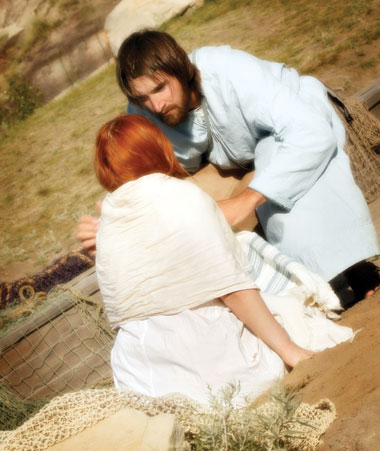 In her book In Every Pew Sits a Broken Heart, Ruth Graham, daughter of evangelist Billy Graham, writes, “My own story is not tidy. Nor is it simple. My story is messy and complicated and still being written. I have known betrayal, divorce, depression and the consequences of bad judgment. I have struggled to parent my children through crisis pregnancy, drug use and an eating disorder. I have known heartbreak, desperation, fear, shame and a profound sense of inadequacy.”
In her book In Every Pew Sits a Broken Heart, Ruth Graham, daughter of evangelist Billy Graham, writes, “My own story is not tidy. Nor is it simple. My story is messy and complicated and still being written. I have known betrayal, divorce, depression and the consequences of bad judgment. I have struggled to parent my children through crisis pregnancy, drug use and an eating disorder. I have known heartbreak, desperation, fear, shame and a profound sense of inadequacy.”
Ruth Graham's story is not unique. But she is one of the few Christian leaders courageous enough to share it with others. “Once we take off our masks, once we expose our ruins, we give others permission to do the same,” she admits. “That is when real ministry and healing take place.”
Women are better than men at revealing their inner pain with tears, although it was a man, Gregory of Nyssa, who is attributed with a description of tears as “blood from the wounds of the soul.” Tears evoke many responses. But Jesus' responses model God's reaction to our tears.
Drop, drop slow tears
In your deep floods
Drown all my faults and fears …
Nor let his eye
See sin, but through my tears.
—Phineas Fletcher
Even a casual reader of the Gospels can't help but notice that Jesus had a soft spot for weeping women. In a society where belittlement of women was common, it's shocking that a man should respond to tears without embarrassed condescension or scorn. That Jesus, the divine Man sent to reveal God's heart, took women's tears so seriously should bring hope to all who find themselves caught in the grip of sorrow. There are four stories in the Gospels where Jesus responded specifically and definitively to women who wept out their heart's desire in a flood of tears.
In the Grip of Sorrow
Luke 7 recounts two astonishing stories of weeping women and Jesus' tender responses. The first (see Luke 7:11-17) is surprising because there was no demand placed on Jesus. No pleading prefaced this miracle. It was purely volitional on Jesus' part, as he instinctively reached out to the starkness of a woman's need. Upon entering the town of Nain, Jesus was met with a funeral procession. On the bier was the only son of a widow, being carried out of the town to be buried. Jesus' heart went out to the sobbing woman, bereft and lonely in a crowd of mourners. She was too grief-stricken to verbalize her need. She didn't dare to ask for anything. Her hope had been utterly crushed. Yet Jesus, feeling pity for her, told her not to cry. Then he touched the bier, spoke to the dead man and, when the corpse sat up and began to talk, gave him back to his mother. Weeping was replaced by awe; tears were exchanged for praise.
Jesus went to great lengths to provide for those whom his disciples easily dismissed or uncomfortably tried to silence
In the second story (see Luke 7:36-50), a Pharisee hosted Jesus at his residence. He woodenly offered the bare minimum of hospitality to Jesus, while a wayward woman bathed Jesus' feet with her tears and perfume. The contrast is striking. Jesus castigated the Pharisee, pointing out his many omissions: “You did not give me any water for my feet.… You did not give me a kiss.… You did not put oil on my head.” But to the woman, who loved much, Jesus offered forgiveness. The story clearly points to the divinity of Jesus, for who could forgive sins but God? It also highlights the faith of the woman, who was ultimately more generous and giving than the host. Jesus gave her this benediction: “Your faith has saved you; go in peace.”
In Mark's Gospel, the significance of the woman's act of worship is relayed from Jesus' perspective: “She poured perfume on my body beforehand to prepare for my burial. Truly I tell you, wherever the gospel is preached throughout the world, what she has done will also be told, in memory of her” (Mark 14:8-9). Commentators have remarked that the scent of the perfume she lavished on Jesus may have lingered during the days leading up to the crucifixion. For Jesus, it would have been a fragrant reminder of her costly sacrifice and the costly sacrifice that lay ahead for him.
Jesus Wept
The final two Gospel stories of weeping women are bookends to the Crucifixion and Resurrection of Jesus. The first portrays Mary and Jesus weeping together (see John 11:33-35). The identity of Mary has troubled commentators, but we are told in John 11:2, that this Mary of Bethany, sister of Martha and Lazarus, was the same one who poured perfume on the Lord and wiped his feet with her hair. This weeping, however, was in a different spirit. It was a bitter Mary who accused Jesus of not being there for her and her brother and consequently being responsible for Lazarus' death.
Mary's accusation opens an unparallelled window on Jesus' emotions. The account says that Jesus was “deeply moved in spirit and troubled” (John 11:33). Whether he was troubled because of the heartbreak of his friends or their lack of faith, or whether he could see beyond Lazarus' death and resurrection to what he himself would have to endure in a few days, we don't know. But his verbal response was to ask to see the body of Lazarus. Then, we are told, Jesus wept. Jesus was not so much of a man that he could not cry in response to a woman's tears.
The crowd of Jews following Mary and Martha—the funeral goers—reacted to Jesus' tears by remarking, “See how he loved him!” But John emphasizes that Jesus was once more deeply moved as he came to the tomb.
This was a traumatic moment for Jesus. Given what was to follow, why was this occasion not more joyous and triumphant? The raising of Lazarus would cause many to put their faith in Christ, but it would also lead to renewed plots to take Jesus' life and curtail his public activity. Jesus, who so clearly discerned people's real motives, could not help but feel torn as he counted the cost of assuaging Mary's tears.
“Why Are You Crying?”
The final glimpse of Jesus responding to a woman's tears is set in the Garden of Gethsemane in the early morning hours (see John 20:1-18). The woman was Mary Magdalene, out of whom Jesus had cast seven demons. Ever since he saved her, Mary had been one of the women travelling with Jesus and the disciples to minister to their needs. She was clearly upset. Coming to minister to the Lord one last time, she discovered that his body was gone. She was denied the opportunity to treat the body with spices and perfume in a final act of service to her beloved Lord. With loud wailings of grief, she distractedly kept repeating, first to Peter and John, then to the angels, “They have taken my Lord away, and I don't know where they have put him.” She wouldn't leave, even after Peter and John had assessed the situation and returned to their homes. She was crying so hard that both the angels and Jesus had to ask, “Woman, why are you crying?” in order to get her attention. Recognition finally broke through after Jesus called her by name and she was entrusted to take the message of his Resurrection back to the disciples.
This catalogue of human need marching through the Gospels—a grieving mother, a sinful woman, a bitter sister, a bereft follower—is one that is repeated throughout history in countless lives. It's easy to respond to tears in a perfunctory way. The proffer of a box of tissues. The bewildered waiting for the storm to abate. But these Gospel accounts show a Jesus who was remarkably attuned to human need, willing to reach out to crying women, and to discern the noble virtues that lay behind the tears. Not only that, he went to great lengths to provide for those whom his disciples easily dismissed or uncomfortably tried to silence. Jesus was showing the personality of God.
The response of the Lord today is not likely to be so different. Through his Holy Spirit and his disciples, Jesus can minister to the world's tears of pain and frustration even now. It is the Church's calling to become a safe haven for those who cry. It is the Christian's calling to hear and respond as Jesus would to the brokenhearted.









Leave a Comment